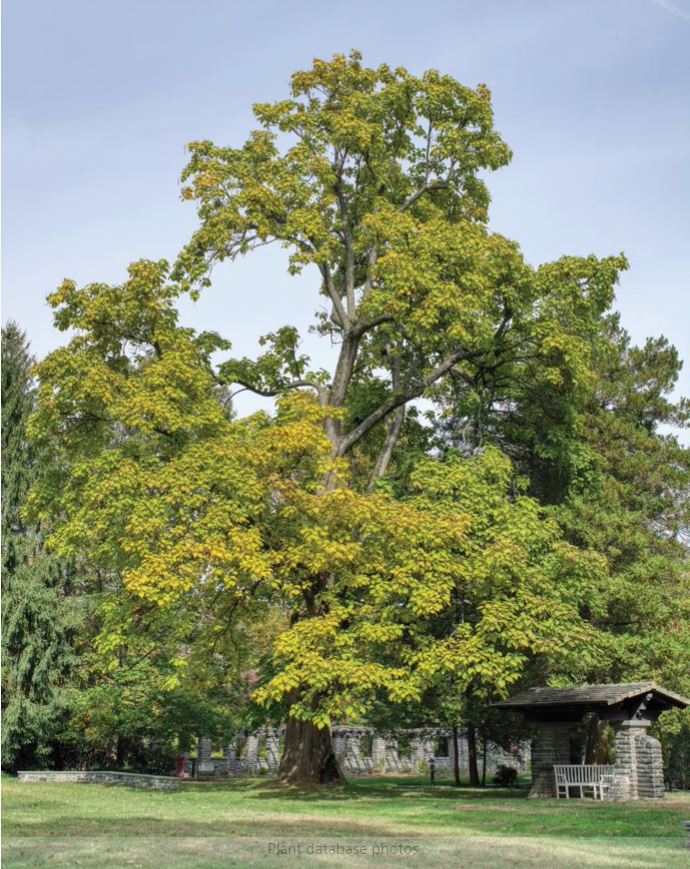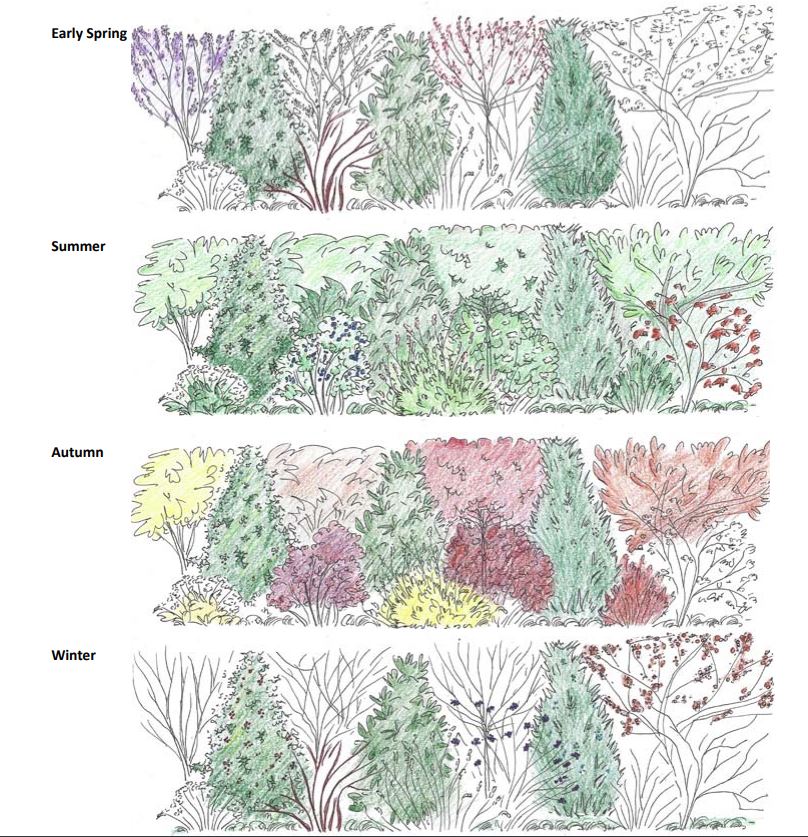Under Heart-Shaped Leaves.
June 16, 2020
Illustration of the water garden at Stoneleigh
In 1914, Samuel Bodine, then the owner of a 65-acre estate in Villanova known as Stoneleigh, directed the construction of a tennis court on his property. He hired a pair of renowned architects, John Charles Olmsted and Frederick Law Olmsted, Jr., to design the landscape feature. Trees and shrubs were added to screen the court from the rest of the grounds, creating an intimate space. One spectacular specimen at the edge of the new tennis court was an already mature southern catalpa (Catalpa bignonioides), popular for its showy, orchid-like blossoms in summer and its large, heart-shaped leaves.

Photo by David Korbonits
Today, that catalpa tree is the fourth largest of its kind in Pennsylvania, with a massive trunk measuring 204 inches around and a spread of 63 feet. The tree measures 82 feet tall, a remarkable height for a species that usually caps out at 40 feet. Its height is even more remarkable, considering the Stoneleigh tree lost a huge section of its main trunk in a storm decades ago.
Catalpa trees are native to the United States. Indigenous people called them “catawba,” but the colonial botanist who wrote the formal scientific description of the genus made a transcription error. The rules of botanical naming, originated by Swedish botanist Carl Linnaeus in the mid-18th century, state that the spelling used in the formal scientific description has to be retained for the scientific name. Thus, the name catalpa.
This ancient tree is the inspiration and setting for Stoneleigh’s newest garden: Catalpa Court, made possible by a generous and special donor.
The centerpiece of the new space—scheduled for construction later this year—is a 50-foot by 18-foot water feature. A circulator pump will allow the water to cascade over infinity edges and be pumped back into the pool via a biofiltration bed running down its center. True to Stoneleigh’s commitment to garden practices that promote ecological diversity, aquatic and marginal plants like American lotus and hardy hibiscus will clean and filter the water without the use of chlorine or other chemicals. The pool will be an inviting habitat for frogs, toads, beneficial insects, and birds. The edge of the pool will be made of stone and will double as a place for guests to sit and enjoy the new feature.
“Many Olmsted-designed landscapes include water features, and we loved the idea of adding to the sense of tranquility at Stoneleigh,” said Ethan Kauffman, director of Stoneleigh. “Can’t you just picture sitting there with the sound of trickling water, birdsong, and a breeze rustling the catalpa leaves above?”
The water feature will be encircled with plants—much like the old tennis court once was, but with an emphasis on biodiversity rather than a single species. Stoneleigh horticulturists will plant a 10-foot-wide hedge filled with dozens of different types of native trees and shrubs. “The hedge that once surrounded this space consisted of only eastern hemlock,” said Kauffman. “But a single species really limits the color, texture, and season of interest of the planting, not to mention the wildlife value. Our take on a screening hedge is one that is bursting with beauty through every season.”

In the footprint of the historic eastern hemlock hedge will be a diverse new wildlife hedge. It will be composed of more than 100 species of native trees and shrubs, which provide a variety of food sources and cover for wildlife. It will also produce an exciting and dynamic display of flowers, foliage color, and texture throughout all seasons. Illustration by Laura Cruz
Catalpa Court is the result of a collaborative design process involving most of the six-person team of gardeners at Stoneleigh along with input from other Natural Lands’ landscape architects. “We brainstormed, sketched, and staged on site,” said horticulturist Laura Cruz, who drew the concept plans. “And choosing the interesting, unexpected plants for the wildlife hedge and perennial gardens was both complex and enjoyable.”
The essence of this new addition to Stoneleigh is enhancing the guest experience. The nearby pavilion— created two years ago as a place for family and friends to gather, eat a picnic meal, and enjoy the garden scenery— was a useful feature but it needed something to anchor the space once occupied by the old tennis court.
“The Bodine and Haas families loved this part of Stoneleigh because it drew them together as a family in the outdoors,” said Oliver Bass, president of Natural Lands. Standing beneath the ancient catalpa tree on the site, he picked up one of its signature heart-shaped leaves. “It is our sincere hope that Catalpa Court will offer something similar to our guests… that they find inspiration, enjoyment, and a sense of wonder in this special space.”
generosity makes this garden grow.
Donated to Natural Lands in 2016 by the family of John and Chara Haas, Stoneleigh: a natural garden has become a destination for tens-of-thousands of visitors who are inspired by our commitment to ecological biodiversity, sustainable design, and native plants. As the property has transitioned from private to public space, it has taken many hands, many hours, and many volunteers—gifts in and of themselves—to make this garden grow.
Philanthropic investments have planted equally important seeds, and two recent gifts in particular will have an important impact on Stoneleigh’s future.
The first generous gesture inspired Catalpa Court. “The Bodine family has been close to Stoneleigh for many generations,” explained Jean Bodine. “We wanted to do something to celebrate the extraordinary Haas family gift that now enables the public to enjoy the gardens and learn about the natural world, and hope the water feature will add to the visitor experience.”
“We can hardly contain our enthusiasm for all that Catalpa Court will add to the Stoneleigh experience,” said President Oliver Bass. “We are moved by the Bodine family’s affection for the garden and commitment to the environmental health of our region.”
Another donor—equally moved by all that Stoneleigh has afforded them in the time it has been open to the public—stepped forward in 2019 to discuss a gift toward an unfunded garden priority. The wonderful outcome is a generous and anonymous contribution to create an endowment for a paid summer internship program at Stoneleigh.
“Philadelphia is regarded as the Garden Capital of America—a distinction that includes a long history of well-respected internship programs, many of which have helped catapult the careers of some of our most important garden leaders.” said Ethan Kauffman, Stoneleigh’s director. “Thanks to this gift, Stoneleigh can now imprint its mission goals on the next generation of horticulturists, beginning with our first intern hire this summer.”
Added Kauffman, “My staff and I are in awe of the impetus to share, which began with the Hasses and now includes so many others. As we continue our business of tending to Stoneleigh, our hearts are full of appreciation for the generosities that enable the garden to grow.”
next post
I Don't Just Love'em – I Lichen
June 7, 2020
by Tim Burris, Preserve Manager. So, one of the upsides of the pandemic has been better air quality. More empty roads and more empty work […]
continue reading